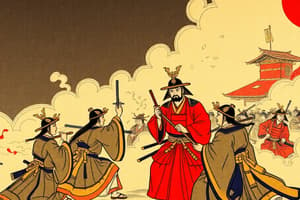Podcast
Questions and Answers
Which historical period does the handwritten notes and diagrams relate to?
Which historical period does the handwritten notes and diagrams relate to?
- Heian period
- Tokugawa period (correct)
- Meiji period
- Edo period (correct)
What aspect of the Edo period is likely included in the notes and diagrams?
What aspect of the Edo period is likely included in the notes and diagrams?
- Cultural exchanges with Europe
- Artistic movements
- Economic theories
- Establishment and structure of the Edo Shogunate (correct)
What type of information is likely organized in tables and lists within the study guide?
What type of information is likely organized in tables and lists within the study guide?
- Modern Japanese legal systems
- Technological advancements of the period
- Historical figures, events, and institutions (correct)
- Current events related to Japan
What is absent from the content related to the image?
What is absent from the content related to the image?
What can be inferred about the study guide's focus?
What can be inferred about the study guide's focus?
Flashcards
Edo Period
Edo Period
A time in Japanese history from 1603 to 1868, marked by peace and stability under the Tokugawa shogunate.
Tokugawa Shogunate
Tokugawa Shogunate
The last feudal Japanese military government, established by Tokugawa Ieyasu, ruling during the Edo period.
Class Structure
Class Structure
A system of societal organization in Edo Japan, consisting of samurai, peasants, artisans, and merchants.
Isolationist Policy
Isolationist Policy
Signup and view all the flashcards
Cultural Flourishing
Cultural Flourishing
Signup and view all the flashcards
Study Notes
Tokugawa Shogunate Establishment and Policies
- The Tokugawa Shogunate, established in 1603, replaced the previous Toyotomi government.
- Tokugawa Ieyasu defeated Ishida Mitsunari in the Battle of Sekigahara (1600).
- Ieyasu became the Seii Taishogun (general who subjugates the barbarians) in 1603.
- This marked the beginning of the Edo period.
Bakufu System Consolidation
- The establishment of the Bakufu system (military government) involved a hierarchical structure.
- The Shogunate controlled daimyo (feudal lords).
- Daimyo were categorized as Shinpan, Fudai, and Tozama.
- Shinpan (closely related) were loyal to the Tokugawa family.
- Fudai (intimate retainers) supported Tokugawa before the Battle of Sekigahara.
- Tozama (outsiders) joined the Tokugawa later.
- The Shogunate controlled daimyo through various methods.
Key Policies and their Purpose
- Bukke Shohatto: A code regulating the behavior of daimyo, including military conduct and propriety.
- Sankin Kotai: A policy requiring daimyo to reside in Edo (Tokyo), alternating with time in their domains. This policy had several purposes:
- Weaken daimyo financially.
- Monitor daimyo closely.
- Strengthen Tokugawa control.
- Other important policies included the supervision of temples and shrines (Tera-shashu bugyo) and other regional officials (e.g. Kyoto shoshidai, Osaka jōdai).
Tokugawa Iemitsu Administration
- The third Shogun, Iemitsu, intensified the existing policies to solidify the control of the Tokugawa Shogunate.
- Key policies such as Sankin Kotai were enforced stringently.
Studying That Suits You
Use AI to generate personalized quizzes and flashcards to suit your learning preferences.




